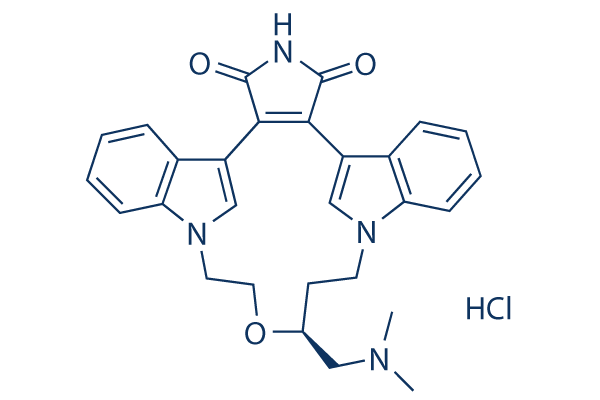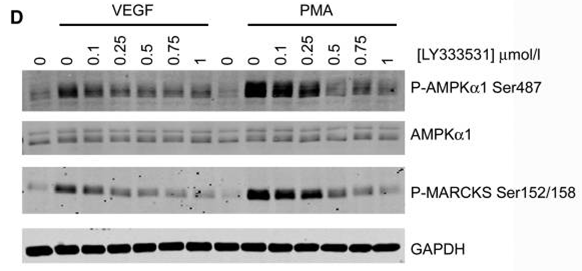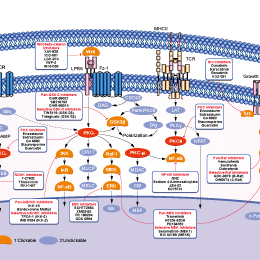
- Bioactive Compounds
- By Signaling Pathways
- PI3K/Akt/mTOR
- Epigenetics
- Methylation
- Immunology & Inflammation
- Protein Tyrosine Kinase
- Angiogenesis
- Apoptosis
- Autophagy
- ER stress & UPR
- JAK/STAT
- MAPK
- Cytoskeletal Signaling
- Cell Cycle
- TGF-beta/Smad
- DNA Damage/DNA Repair
- Compound Libraries
- Popular Compound Libraries
- Customize Library
- Clinical and FDA-approved Related
- Bioactive Compound Libraries
- Inhibitor Related
- Natural Product Related
- Metabolism Related
- Cell Death Related
- By Signaling Pathway
- By Disease
- Anti-infection and Antiviral Related
- Neuronal and Immunology Related
- Fragment and Covalent Related
- FDA-approved Drug Library
- FDA-approved & Passed Phase I Drug Library
- Preclinical/Clinical Compound Library
- Bioactive Compound Library-I
- Bioactive Compound Library-Ⅱ
- Kinase Inhibitor Library
- Express-Pick Library
- Natural Product Library
- Human Endogenous Metabolite Compound Library
- Alkaloid Compound LibraryNew
- Angiogenesis Related compound Library
- Anti-Aging Compound Library
- Anti-alzheimer Disease Compound Library
- Antibiotics compound Library
- Anti-cancer Compound Library
- Anti-cancer Compound Library-Ⅱ
- Anti-cancer Metabolism Compound Library
- Anti-Cardiovascular Disease Compound Library
- Anti-diabetic Compound Library
- Anti-infection Compound Library
- Antioxidant Compound Library
- Anti-parasitic Compound Library
- Antiviral Compound Library
- Apoptosis Compound Library
- Autophagy Compound Library
- Calcium Channel Blocker LibraryNew
- Cambridge Cancer Compound Library
- Carbohydrate Metabolism Compound LibraryNew
- Cell Cycle compound library
- CNS-Penetrant Compound Library
- Covalent Inhibitor Library
- Cytokine Inhibitor LibraryNew
- Cytoskeletal Signaling Pathway Compound Library
- DNA Damage/DNA Repair compound Library
- Drug-like Compound Library
- Endoplasmic Reticulum Stress Compound Library
- Epigenetics Compound Library
- Exosome Secretion Related Compound LibraryNew
- FDA-approved Anticancer Drug LibraryNew
- Ferroptosis Compound Library
- Flavonoid Compound Library
- Fragment Library
- Glutamine Metabolism Compound Library
- Glycolysis Compound Library
- GPCR Compound Library
- Gut Microbial Metabolite Library
- HIF-1 Signaling Pathway Compound Library
- Highly Selective Inhibitor Library
- Histone modification compound library
- HTS Library for Drug Discovery
- Human Hormone Related Compound LibraryNew
- Human Transcription Factor Compound LibraryNew
- Immunology/Inflammation Compound Library
- Inhibitor Library
- Ion Channel Ligand Library
- JAK/STAT compound library
- Lipid Metabolism Compound LibraryNew
- Macrocyclic Compound Library
- MAPK Inhibitor Library
- Medicine Food Homology Compound Library
- Metabolism Compound Library
- Methylation Compound Library
- Mouse Metabolite Compound LibraryNew
- Natural Organic Compound Library
- Neuronal Signaling Compound Library
- NF-κB Signaling Compound Library
- Nucleoside Analogue Library
- Obesity Compound Library
- Oxidative Stress Compound LibraryNew
- Plant Extract Library
- Phenotypic Screening Library
- PI3K/Akt Inhibitor Library
- Protease Inhibitor Library
- Protein-protein Interaction Inhibitor Library
- Pyroptosis Compound Library
- Small Molecule Immuno-Oncology Compound Library
- Mitochondria-Targeted Compound LibraryNew
- Stem Cell Differentiation Compound LibraryNew
- Stem Cell Signaling Compound Library
- Natural Phenol Compound LibraryNew
- Natural Terpenoid Compound LibraryNew
- TGF-beta/Smad compound library
- Traditional Chinese Medicine Library
- Tyrosine Kinase Inhibitor Library
- Ubiquitination Compound Library
-
Cherry Picking
You can personalize your library with chemicals from within Selleck's inventory. Build the right library for your research endeavors by choosing from compounds in all of our available libraries.
Please contact us at info@selleckchem.com to customize your library.
You could select:
- Antibodies
- Bioreagents
- qPCR
- 2x SYBR Green qPCR Master Mix
- 2x SYBR Green qPCR Master Mix(Low ROX)
- 2x SYBR Green qPCR Master Mix(High ROX)
- Protein Assay
- Protein A/G Magnetic Beads for IP
- Anti-Flag magnetic beads
- Anti-Flag Affinity Gel
- Anti-Myc magnetic beads
- Anti-HA magnetic beads
- Poly DYKDDDDK Tag Peptide lyophilized powder
- Protease Inhibitor Cocktail
- Protease Inhibitor Cocktail (EDTA-Free, 100X in DMSO)
- Phosphatase Inhibitor Cocktail (2 Tubes, 100X)
- Cell Biology
- Cell Counting Kit-8 (CCK-8)
- Animal Experiment
- Mouse Direct PCR Kit (For Genotyping)
- New Products
- Contact Us
research use only
Ruboxistaurin (LY333531) HCl PKC inhibitor
Ruboxistaurin (LY333531) HCl is a β-specific protein kinase C inhibitor. It competitively and reversibly inhibits PKCβ1 and PKCβ2 with IC50 values of 4.7 and 5.9 nM respectively.

Chemical Structure
Molecular Weight: 505.01
Purity & Quality Control
Batch:
Purity:
99.65%
99.65
Products Often Used Together with Ruboxistaurin (LY333531) HCl
It and gp91ds-tat combined with therapeutic hypothermia substantially accelerate human brain microvascular endothelial cells (HBMEC) wound closure.
It and GLP-1 (7-37) combination enhances the reduction of NOX4 expression via PKCβ inhibition.
Related Products
| Related Targets | PKCα PKCβ PKCγ PKCδ PKCε PKCζ PKCη PKCθ PKCι | Click to Expand |
|---|---|---|
| Related Products | Go 6983 Sotrastaurin (AEB071) Enzastaurin Bisindolylmaleimide I (GF109203X) PMA (Phorbol 12-myristate 13-acetate) Go6976 Bisindolylmaleimide IX (Ro 31-8220) Mesylate Rottlerin PKC-theta inhibitor Chelerythrine Chloride (NSC 646662) Darovasertib (LXS-196) Epsilon-V1-2 Dequalinium Chloride Myricitrin VTX-27 Chelerythrine | Click to Expand |
| Related Compound Libraries | Kinase Inhibitor Library PI3K/Akt Inhibitor Library MAPK Inhibitor Library Cell Cycle compound library TGF-beta/Smad compound library | Click to Expand |
Signaling Pathway
Cell Culture and Working Concentration
| Cell Lines | Assay Type | Concentration | Incubation Time | Formulation | Activity Description | PMID |
|---|---|---|---|---|---|---|
| MOLM13 | Apoptosis assay | Induction of apoptosis in human MOLM13 cells, IC50=0.7 μM | 18077363 | |||
| MV4-11 | Apoptosis assay | Induction of apoptosis in human MV4-11 cells, IC5=1.5 μM | 18077363 | |||
| endothelial cells | Function assay | Effective dose against plasminogen activator activity stimulated by phorbol ester in endothelial cells, ED50=7.5μM | 8709095 | |||
| MV4-11 | Function assay | 1 uM | Reduction of BAD phosphorylation in human MV4-11 cells at 1 uM by Western blot | 18077363 | ||
| Click to View More Cell Line Experimental Data | ||||||
Mechanism of Action
| Targets |
|
|---|
In vitro |
||||
| In vitro | LY333531 strikingly decreases the chance of HUVEC survival and the effect of LY333531 on apoptotic cell death in HUVEC significantly increases compared with the AGEs group. Blockade of PKC-beta up-regulates the expression of Bax and Bad proteins and down-regulates the expression of Bcl-2 protein. Moreover, LY333531 reduces the ratio of Bcl-2/Bax. LY333531 can further prompt AGEs-induced endothelial cells apoptosis. The increased expression of Bax, Bad and decreased expression of Bcl-2 and Bcl-2/Bax ratio are associated with the apoptotic process[3]. | |||
|---|---|---|---|---|
| Cell Research | Cell lines | Human umbilical vein endothelial cell (HUVEC) | ||
| Concentrations | 200 nM | |||
| Incubation Time | 48 h | |||
| Method | HUVECs are seeded into 96-well plates in low glucose DMEM with 10% FBS for 12 h. Afterwards, HUVECs are starved for 12 h and incubated with BSA (200 μg/ml), AGEs (200 μg/ml) and LY333531 (200 nM)+AGEs (200 μg/ml) for 48 h. Then, the medium is replaced with 0.5 mg/ml MTT and at 37 ◦C in a 95% air/5% CO2 incubator for 4 h. Finally, the medium containing MTT is aspirated and replaced by dimethyl sulphoxide (DMSO). OD is measured with a Microplate spectrophotometer. AGEs:advanced glycation end products. | |||
| Experimental Result Images | Methods | Biomarkers | Images | PMID |
| Western blot | p-AMPKα1 / AMPKα1 / p-MARCKS |

|
27784766 | |
In Vivo |
||
| In vivo | LY333531 treatment (for a duration of 4 weeks) prevents excessive PKCb2 activation and attenuates cardiac diastolic dysfunction in rats with streptozotocin-induced diabetes. LY333531 suppresses the decreased expression of myocardial NO, Cav-3, phosphorylated (p)-Akt, and p-eNOS and also mitigates the augmentation of O2-, nitrotyrosine, Cav-1, and iNOS expression[2]. | |
|---|---|---|
| NCT Number | Recruitment | Conditions | Sponsor/Collaborators | Start Date | Phases |
|---|---|---|---|---|---|
| NCT00297401 | Completed | Diabetes Mellitus Type 1 |
Chromaderm Inc.|Heart and Stroke Foundation of Canada |
March 2006 | Phase 3 |
| NCT00190970 | Completed | Diabetic Neuropathy |
Chromaderm Inc. |
October 2004 | Phase 2 |
| NCT00482976 | Completed | Diabetes Mellitus |
Chromaderm Inc.|Joslin Diabetes Center |
December 2003 | Phase 2 |
References |
|
Chemical Information
| Molecular Weight | 505.01 | Formula | C28H28N4O3.HCl |
| CAS No. | 169939-93-9 | SDF | Download SDF |
| Synonyms | Ruboxistaurin hydrochloride, LY333531 hydrochloride | ||
| Smiles | CN(C)CC1CCN2C=C(C3=CC=CC=C32)C4=C(C5=CN(CCO1)C6=CC=CC=C65)C(=O)NC4=O.Cl | ||
Storage and Stability
| Storage (From the date of receipt) | |||
|
In vitro |
DMSO : 100 mg/mL ( (198.01 mM) Moisture-absorbing DMSO reduces solubility. Please use fresh DMSO.) Water : Insoluble Ethanol : Insoluble |
Molecular Weight Calculator |
|
In vivo Add solvents to the product individually and in order. |
In vivo Formulation Calculator |
|||||
Preparing Stock Solutions
Molarity Calculator
In vivo Formulation Calculator (Clear solution)
Step 1: Enter information below (Recommended: An additional animal making an allowance for loss during the experiment)
mg/kg
g
μL
Step 2: Enter the in vivo formulation (This is only the calculator, not formulation. Please contact us first if there is no in vivo formulation at the solubility Section.)
% DMSO
%
% Tween 80
% ddH2O
%DMSO
%
Calculation results:
Working concentration: mg/ml;
Method for preparing DMSO master liquid: mg drug pre-dissolved in μL DMSO ( Master liquid concentration mg/mL, Please contact us first if the concentration exceeds the DMSO solubility of the batch of drug. )
Method for preparing in vivo formulation: Take μL DMSO master liquid, next addμL PEG300, mix and clarify, next addμL Tween 80, mix and clarify, next add μL ddH2O, mix and clarify.
Method for preparing in vivo formulation: Take μL DMSO master liquid, next add μL Corn oil, mix and clarify.
Note: 1. Please make sure the liquid is clear before adding the next solvent.
2. Be sure to add the solvent(s) in order. You must ensure that the solution obtained, in the previous addition, is a clear solution before proceeding to add the next solvent. Physical methods such
as vortex, ultrasound or hot water bath can be used to aid dissolving.
Tech Support
Answers to questions you may have can be found in the inhibitor handling instructions. Topics include how to prepare stock solutions, how to store inhibitors, and issues that need special attention for cell-based assays and animal experiments.
Tel: +1-832-582-8158 Ext:3
If you have any other enquiries, please leave a message.
* Indicates a Required Field






































